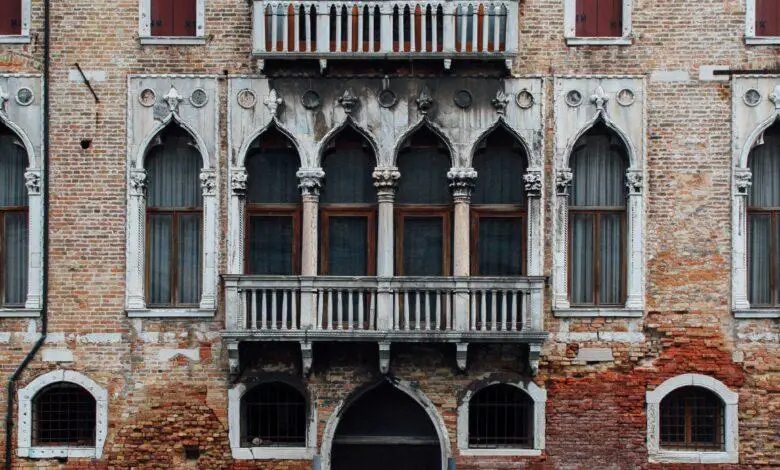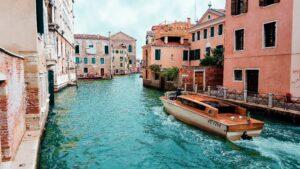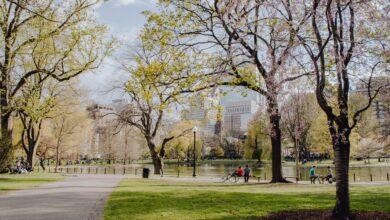The Magic of Venice: Canals and Carnivals 🌆🎭
Unveiling the Charms of Venice's Waterways and Festive Spectacles

Introduction
There’s a city where streets are made of liquid, where canals replace roads, and where masks and costumes bring dreams to life. Welcome to Venice, Italy, a place where magic seeps from every cobblestone and where tradition dances with revelry in a symphony of colors. In this blog post, we invite you to delve into the enchanting world of Venice, a city that’s uniquely poised between history and fantasy. Beyond the serene canals and historic streets, we’ll also unveil the vivacious spirit of Venice’s world-renowned carnival. It’s a city where the past whispers through the lapping of water, where hidden gems await discovery, and where every step leads to a deeper understanding of a place unlike any other. So, don your Venetian mask, and let’s embark on a journey to explore the captivating magic of Venice.
Venice’s Canals: The Liquid Streets
Exploring the Grand Canal by Vaporetto
Venice’s Grand Canal, often referred to as the “Main Street” of the city, offers a breathtaking journey through the heart of this unique Italian destination. One of the most convenient and enjoyable ways to explore this liquid street is by taking a vaporetto, the city’s waterbus. The vaporetto is a practical mode of transportation, but it also doubles as a scenic tour.
As you glide along the Grand Canal on a vaporetto, you’ll be treated to picturesque views of historic palaces, colorful buildings, and bustling squares. It’s a dynamic experience that provides a window into Venetian life and culture. From the iconic Rialto Bridge to the serene Accademia Bridge, you’ll pass under a variety of charming structures, each with its own story to tell.
For those in search of an authentic Venetian experience, consider taking a leisurely ride at sunset. The warm, golden light dancing on the water’s surface creates an enchanting atmosphere that you won’t soon forget. Don’t forget to bring your camera to capture the beauty of this extraordinary journey through Venice’s liquid streets.
Gondolas, Traghetto, and Other Unique Modes of Water Transport
Venice is renowned for its unconventional modes of water transport. While the gondola may be the most famous, there are other unique options to explore. Gondolas, with their elegant black hulls and skilled gondoliers, offer a romantic and iconic experience. Glide through narrow canals and enjoy a personalized tour of the city’s hidden gems.
For those seeking a more budget-friendly option, consider the traghetto. This large, shared gondola ferries passengers across the Grand Canal at various points. It’s a quick and economical way to experience a bit of gondola charm without the expense of a private ride.
Alternatively, try the vaporetto, which serves as the city’s primary waterbus system, connecting Venice’s islands and offering a more local perspective. Whichever mode of water transport you choose, you’ll be immersed in the enchanting, aquatic culture of Venice.
Venice’s Iconic Bridges and Their Stories
Venice is a city of bridges, each with its own history and unique character. While the city is known for its canals, the bridges that span them are equally fascinating. The Rialto Bridge, one of the city’s most famous landmarks, is a magnificent stone structure that has spanned the Grand Canal for centuries. It’s a symbol of commerce and history, and its shops and stalls offer a delightful shopping experience.
The Bridge of Sighs, on the other hand, holds a more somber tale. It connected the Doge’s Palace to the city’s prisons, earning its name from the sighs of prisoners as they caught their last glimpse of Venice before incarceration. Today, it’s a romanticized icon with a storied past.
As you explore Venice’s bridges, you’ll encounter fascinating stories and architectural marvels, making each crossing a unique experience. From the mystical and enchanting atmosphere of the Bridge of Sighs to the bustling grandeur of the Rialto Bridge, these structures are an integral part of Venice’s liquid streets, offering a portal to its rich history and culture.

The Hidden Gems of Venice
The Allure of Venice’s Quiet and Charming Alleyways
While the grandeur of Venice’s canals and famous landmarks is captivating, it’s the quiet and charming alleyways that often hold the city’s most alluring secrets. Wandering through the labyrinthine streets of Venice, you’ll discover hidden gems that provide a more intimate glimpse into the local way of life.
These narrow passageways, known as “calli” in Italian, lead you away from the tourist crowds into a world of authentic Venetian living. You’ll stumble upon family-owned trattorias serving traditional Venetian cuisine, artisan shops crafting unique souvenirs, and quaint squares where locals gather to chat and enjoy their espresso.
Exploring these alleyways can be an adventure in itself, as they often lead to unexpected surprises. You might find yourself in front of a centuries-old church, an artist’s studio, or a tiny gelato shop offering artisanal flavors. The lack of cars and bustling city noises makes these alleys a peaceful respite, allowing you to savor the essence of Venice in a more serene and contemplative way.
Lesser-Known Islands in the Venetian Lagoon
Beyond the famous islands of Murano, Burano, and Torcello, Venice’s lagoon hides a treasure trove of lesser-known gems waiting to be explored. These islands offer a quieter and more authentic experience, away from the tourist crowds.
One such gem is the island of Sant’Erasmo, often referred to as the “Garden of Venice.” Known for its lush greenery and agricultural heritage, Sant’Erasmo is an ideal destination for a peaceful escape. You can explore its vineyards, orchards, and fields while enjoying fresh, local produce.
For a taste of history and culture, consider visiting the island of Mazzorbo, where you’ll find the picturesque vineyard estate of Venissa. This island boasts a unique combination of vineyards, a Michelin-starred restaurant, and traditional craft shops.
And if you’re interested in a more tranquil and remote experience, venture to the island of Pellestrina, where charming fishing villages offer a glimpse into the traditional way of life in the Venetian lagoon.
Offbeat Museums and Galleries
While Venice is renowned for its world-famous art museums and galleries, the city is also home to numerous offbeat and unconventional cultural spaces that offer a fresh perspective on art and history.
One such hidden gem is the Palazzo Contarini del Bovolo, a fascinating architectural masterpiece tucked away in a quiet corner of Venice. This spiral staircase is a true marvel, offering breathtaking views of the city’s rooftops from the top.
The Museo di Storia Naturale (Museum of Natural History) is another underrated attraction, featuring a diverse collection of specimens, including fossils, minerals, and a quirky array of taxidermied animals. It’s a unique destination for those with an interest in natural sciences.
Don’t miss the Peggy Guggenheim Collection, a more well-known but still relatively offbeat museum housing an impressive collection of modern art. The Peggy Guggenheim Collection is a haven for art enthusiasts seeking a break from the crowds at the more famous art venues in the city.
These hidden gems in Venice, whether in its charming alleyways, lesser-known islands, or offbeat museums, offer a chance to experience the city from a new and enchanting perspective. Venture off the beaten path to discover the Venice that locals cherish and treasure.
The Hidden Gems of Venice
The Allure of Venice’s Quiet and Charming Alleyways
While Venice is celebrated for its iconic canals and famous landmarks, some of the city’s most enchanting secrets are concealed within its quiet and charming alleyways. As you meander through the intricate maze of narrow streets, known as “calli” in Italian, you’ll uncover hidden gems that provide a more intimate glimpse into authentic Venetian life.
These quaint alleyways lead you away from the bustling tourist hubs into a world of genuine local culture. Along these winding paths, you might chance upon family-owned trattorias, offering delectable Venetian cuisine, artisan shops crafting unique souvenirs, and cozy squares where residents gather to chat over espresso. It’s in these off-the-beaten-path corners that you can truly savor the essence of Venice.
Each alleyway has its own story to tell, be it a centuries-old church, an artist’s studio, or a tiny gelato shop boasting artisanal flavors. The absence of cars and the serenity of these streets create a peaceful atmosphere, allowing you to immerse yourself in the true spirit of Venice at a leisurely pace.
Lesser-Known Islands in the Venetian Lagoon
Beyond the well-known islands like Murano, Burano, and Torcello, Venice’s lagoon conceals a trove of lesser-explored treasures awaiting your discovery. These islands promise a more serene and authentic experience, away from the tourist hustle and bustle.
Sant’Erasmo, often called the “Garden of Venice,” is a prime example. Renowned for its lush greenery and agricultural heritage, it offers a tranquil escape. Stroll through vineyards, orchards, and fields, and relish the taste of fresh, locally grown produce.
For a touch of history and culture, Mazzorbo boasts the enchanting Venissa vineyard estate. Here, you’ll find a unique blend of vineyards, a Michelin-starred restaurant, and traditional craft shops. It’s a delightful blend of Venetian heritage and contemporary excellence.
And for those seeking a remote and peaceful experience, Pellestrina’s charming fishing villages provide insight into the traditional lifestyle of the Venetian lagoon, far from the crowds of the city.
Offbeat Museums and Galleries
While Venice is famed for its renowned art museums and galleries, the city also harbors numerous offbeat and unconventional cultural spaces that offer a fresh perspective on art and history.
The Palazzo Contarini del Bovolo, an architectural marvel tucked away in a quiet corner, features a captivating spiral staircase that offers panoramic views of Venice’s rooftops from the top.
Venture to the Museo di Storia Naturale (Museum of Natural History) to explore an intriguing collection of specimens, from fossils to minerals, alongside a quirky array of taxidermied animals. It’s a unique destination for those with an interest in the natural world.
Lastly, the Peggy Guggenheim Collection, though relatively well-known, provides an offbeat museum experience with its exceptional collection of modern art. It’s a haven for art enthusiasts seeking respite from the crowds at more famous art venues in the city.
These hidden gems in Venice, whether within its charming alleyways, on lesser-known islands, or inside offbeat museums and galleries, offer a chance to experience the city from a fresh and enchanting perspective. Venture off the well-trodden path to discover the Venice that locals hold dear and cherish.
Venetian Cuisine and Culinary Delights
Traditional Venetian Dishes and Seafood Specialties
Venetian cuisine is a celebration of flavors and history, deeply rooted in the city’s maritime heritage. The culinary delights of Venice showcase a unique blend of traditional Italian dishes with a distinct local twist. One cannot explore Venice’s culinary landscape without indulging in the city’s renowned seafood specialties.
Start your gastronomic journey with “risotto al nero di seppia,” a sumptuous black squid ink risotto. This iconic Venetian dish boasts a rich, briny flavor and is as visually striking as it is delicious. Equally famous is “fritto misto,” a medley of fried seafood that tantalizes the taste buds with its crispy perfection.
Don’t miss out on “sarde in saor,” a delightful appetizer of marinated sardines with sweet and sour onions, reflecting Venice’s historic maritime connections. You can also savor “bacalà mantecato,” a creamy spread made from salted cod, which has been a Venetian favorite for centuries.
As you explore the city, be sure to try “sarde in saor,” a delightful appetizer of marinated sardines with sweet and sour onions, reflecting Venice’s historic maritime connections. You can also savor “bacalà mantecato,” a creamy spread made from salted cod, which has been a Venetian favorite for centuries.
The Charm of Cicchetti and Venetian Wine Bars
Venetian culinary culture wouldn’t be complete without the charm of “cicchetti” and the cozy ambiance of Venetian wine bars, locally known as “bacari.” These small, delectable snacks are the heart and soul of social dining in Venice.
Cicchetti are bite-sized, flavorful morsels that come in various forms, from fresh seafood to delectable cured meats. A popular cicchetti option is the “baccalà mantecato,” a creamy cod spread, often served on a slice of crusty bread. These delectable bites are perfect accompaniments to a glass of local Venetian wine.
The city’s wine bars, or bacari, offer an inviting atmosphere for locals and tourists alike. It’s a tradition to stop by a bacaro and enjoy cicchetti with a glass of Venetian wine or a “spritz,” a refreshing aperitif made with Prosecco, Aperol, and a splash of soda. The friendly chatter, the clinking of glasses, and the delightful aromas make for a memorable experience.
The Art of Sipping Coffee in Venice’s Historic Cafés
Venice’s historic cafés are more than just places to grab a quick caffeine fix; they are cultural institutions and a reflection of the city’s elegant lifestyle. Sipping coffee in Venice is an art form, and the city’s historic cafés provide the perfect setting for this ritual.
Start your day with a “cappuccino” or “espresso” at iconic cafés like Caffè Florian, one of the oldest coffeehouses in Europe. It’s a splendid spot to savor your coffee while immersed in the grandeur of St. Mark’s Square.
For a more local experience, venture into the narrow streets to find “bacari” offering coffee with a Venetian twist. Try a “caffè corretto,” an espresso “corrected” with a shot of grappa or sambuca, a perfect example of how Venice marries its coffee culture with its love for spirits.
Exploring traditional Venetian dishes, indulging in cicchetti at local wine bars, and savoring coffee in historic cafés are essential culinary experiences that showcase Venice’s rich gastronomic heritage. These delights not only satisfy your taste buds but also provide a glimpse into the city’s culture and way of life.
Practical Tips for Your Venice Adventure
Best Times to Visit Venice
Choosing the best time to visit Venice can greatly enhance your experience in the city of canals. To avoid the peak tourist season, plan your trip in the spring (March to May) or early autumn (September to October). During these months, the weather is generally pleasant, and the crowds are less overwhelming, allowing you to explore Venice’s hidden gems with ease.
While Venice is beautiful year-round, the city experiences flooding in the late autumn and winter months, so be aware of the “aqua alta” phenomenon and plan accordingly. Also, keep in mind that summer (June to August) is the busiest season, with long lines and higher prices. If you must visit in summer, consider booking your accommodations and tours well in advance.
Navigating the Canals and Understanding Vaporetto Routes
Venice’s intricate network of canals is enchanting, but it can be challenging to navigate, especially for first-time visitors. To make the most of your adventure, acquaint yourself with the vaporetto system, Venice’s waterbus service.
The vaporetto is an efficient and affordable way to travel between the islands and explore the Grand Canal. It’s essential to understand the various routes and stops to get around effortlessly. Consider purchasing a Venice Card, which provides unlimited vaporetto rides for a set duration, making your journeys hassle-free.
Additionally, take time to explore the city on foot. Venice’s compact size makes it a pedestrian-friendly destination, allowing you to stumble upon hidden gems in its charming alleyways and squares.
Respectful Tourism Practices and Cultural Etiquette
Venice is a city deeply steeped in history and culture, and it’s vital to be a responsible and respectful visitor. To ensure you have a positive impact on the city and its residents, follow these guidelines:
- Respect the locals: Venice has a residential population dealing with the challenges of tourism. Be considerate of their daily lives by keeping noise levels down and being polite.
- Mind your step: Venice’s historic buildings and streets may be fragile. Avoid sitting on ancient walls and refrain from touching artwork or historic structures.
- Dispose of your waste responsibly: Venice is committed to environmental sustainability. Use the provided recycling bins and dispose of your waste properly.
- Dress appropriately: When visiting religious sites, cover your shoulders and knees. Modest attire is appreciated out of respect for local customs.
- Support local businesses: Patronize local restaurants, shops, and artisans to contribute to the city’s economy and preserve its unique character.
By embracing these practices and cultural etiquette, you can make your Venice adventure not only enjoyable but also meaningful, respecting the city’s heritage and the people who call it home. Venice’s charm and authenticity are worth preserving for future generations of travelers to enjoy.
FAQs
Q. When is the best time to visit Venice and experience its magical canals and carnivals?
A. The ideal time to visit Venice is during the Carnival, which usually falls in February. This is when you can witness the city’s magical transformation, and the weather is relatively mild. However, Venice’s canals are charming year-round.
Q. What is the significance of the Bridge of Sighs in Venice?
A. The Bridge of Sighs is famous for connecting the Doge’s Palace to the prison. It got its name from the sighs of prisoners who, while crossing the bridge, caught their last glimpse of the outside world. It’s also associated with a romantic legend that kissing under the bridge at sunset ensures eternal love.
Q. Are gondola rides in Venice worth the cost?
A. Yes, a gondola ride is a quintessential Venetian experience. While it might seem expensive, the charm of gliding through Venice’s canals with a gondolier serenading you is priceless. It’s a memory you’ll cherish forever.
Q: Can you participate in the Venice Carnival if you’re not a local?
A. Absolutely! The Venice Carnival is open to visitors from around the world. Many visitors rent or purchase costumes and masks to join in the festivities and celebrations.
Q. How long does the Venice Carnival last?
A. The Venice Carnival typically lasts for around two weeks, with the exact dates varying each year. It begins with the “Flight of the Angel” ceremony and concludes on Shrove Tuesday, just before the start of Lent.
Q. What are some must-try Venetian dishes during the Carnival?
A. When in Venice during the Carnival, don’t miss the opportunity to try Venetian delicacies like frittelle (sweet fritters), galani (fried pastries), and the iconic Venetian hot chocolate.
Conclusion
As we bid arrivederci to the captivating canals and vibrant carnivals of Venice, we hope you’ve glimpsed the unique enchantment that sets this city apart. Venice, with its labyrinthine streets and bridges, its quiet corners and lively piazzas, its rich history and celebration of carnival, holds a special place in the hearts of all who visit. We encourage you to consider a voyage to Venice, for it’s a place that must be experienced firsthand to truly appreciate its timeless charm and revel in the magic that resides in every corner. As you step away from the Venetian world of liquid streets and flamboyant festivities, remember that Venice awaits your exploration, promising a journey of discovery, tradition, and jubilant celebration. Ciao, and may your own Venetian adventure be filled with enchantment and wonder.
Related article





Facebook Comments